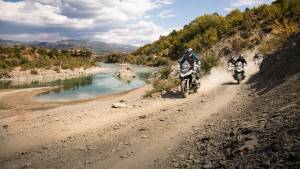Old Yamaha R15 versus new Yamaha R15 version 2.0
The first generation R15 did two things. It gave the enthusiast an immensely capable chassis mated to a scorcher of an engine. It also finally gave the wannabe a fully faired motorcycle and one that shared DNA with two great supersport motorcycles â" the R1 and the R6. The enthusiast and the wannabe both had one complaint each. The enthusiast said â" why only 150cc? The wannabe said â" what's with the skinny rear tyre? A lot of people I know were with me in hoping that the R15 was a sign that Yamaha was going back to their roots and taking note of the enthusiast and not the wannabe or the commuter. We felt that they had finally managed to dig themselves out of the slump they had fallen into following the demise of the RD and the RX. We were so enthralled ready to forgive Yamaha when they gave the R15 a new paintjob and called it a model update. Twice. But when we heard that a reworked R15 was on its way we felt like children on Christmas Eve. We tried our best to poke around everywhere to find out what exactly Yamaha had in store for us. We spent hours hanging around the Yamaha dealerships trying to catch wind of some news. We scoured the web and social media for spy pictures and artists' impressions. And when one of the first real spy pictures came in we thought that the much awaited update was here to bring joy to our world. Imagine our emotions when we found the same 17PS on the spec sheet.
Look at the version 2.0 and you see the same familiar front end only slightly wider with a 90/80 section tyre. Viewed from the front the motorcycle is like Vidya Balan from all her previous movies â" prim, proper and familiar. Move to the side and the bike is as different as the Vidya Balan we see in 'The Dirty Picture' â" whoa! Spearheading this mouth-hanging-open effect is the completely new rear end â" er, I'm talking about the motorcycle, mind you! The rear of the bike is now reminiscent of the R6 and is a gorgeous split seat number ending in a LED tail light and gives the pillion an uninhibited view over the rider's helmet. Yes, it's that high. The seating position is now higher, more focussed and more forward inclined making for a sportier feel and more confidence going into corners. The 2.0 gets a 130 section (up from 100) rear tyre that together with the new tail light and number plate/indicator assembly makes the entire rear end look more substantial than before. The only eyesore is the single piece rear tyre hugger which having being combined with the mudguard cannot be removed unless you have a saw handy. Also, we just cannot understand why the R6 inspired tail section was not used on the R15 when it was launched initially, especially considering the R6's tail has looked like this from even before the R15 was launched.
Now, one of the most disappointing aspects of the new R15 is that it doesn't have any significant performance upgrades. Most of the changes â" like the new circular throttle pulley, ECU, injection maps etc do not make for any change in the power figures which like the old bike remain at 17PS at 8500rpm and 15Nm at 7500rpm. From the word go, both the motorcycles are neck and neck, well almost. The old R15 hit the 60kmph mark in 4.9 seconds, while the version 2.0 got there in 4.79 seconds, a difference of 0.11 seconds. The version 2.0 went on to clock a top speed of 130kmph while the older bike maxed out at 124.5kmph. In a quarter mile drag the newer motorcycle was marginally quicker passing the flag in 18.25 seconds while her predecessor took 18.9 seconds. A difference of 0.65 second is not very heartening for an 'all new' model, we feel. As far as economy goes, the version 2.0 gives 36.3kmpl in the city and 53.04kmpl on the highway, an average of 53.4kmpl while the older bike gives an average of 42.1kmpl (38.7kmpl in the city and 52.3kmpl on the highway).
Yamaha have given the version 2.0 a fatter 130 section rear tyre and a swingarm that is 55mm longer and sturdier. If you remember, the 100 section tyres on the old bike were some of the best in the business. The tyre would stick to tarmac like an unsuspecting kid's tongue sticks to a frozen telephone pole. The bike goes around corners with utmost ease. It will hold a line like it is running on rails. It will let the rider get his knee down as if he was kneeling on a church pew. However the sad part is that the old bike could do all this perfectly well â" did you ever hear or read complaints on the chassis front?
Is the version 2.0 better than the original R15? Numerically, stylistically, appeal-ically, yes. Is it faster around a racetrack? Probably. But in upgrading the chassis without making a corresponding increase in performance, I think the R15's lost just a hint of its sublime engine-chassis balance. The version 2.0 then feels heavier to flick-flack, heavier to steer by a bit, is far less comfy on the street but critically, it now feels like the chassis needs a little more engine to truly shine. And philosophically speaking, Yamaha have created the 2.0 to ensure that all the wannabes, the chaps who didn't care as long as it was all plastic and fat tyres are sated. That's the commuter mentality creeping back in. Now, the only silver lining I can see in this is the hope that the chassis is slightly overconfigured because a larger engine is on its way. One that will take the fat tyre and that long swingarm by their necks and make them work for their money, just like the first R15 did so sublimely. The R15 version 2.0 is better than the R15 in many, many ways. But having ridden both back to back, I'm not sure its the right upgrade for a motorcycle that is sure to be a chapter in Indian motorcycling history all on its own. There just isn't enough meat in the upgrade for that.
Starts Rs 1,02,700
149cc
5-Speed
12.40
13.60
-NA-














